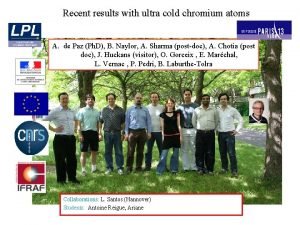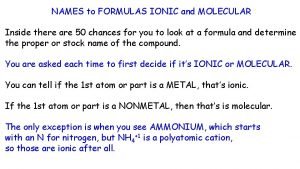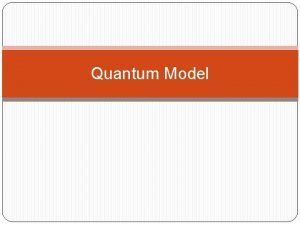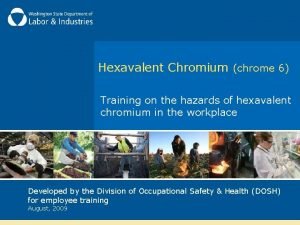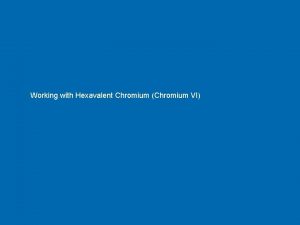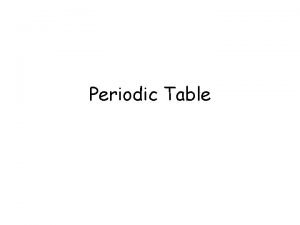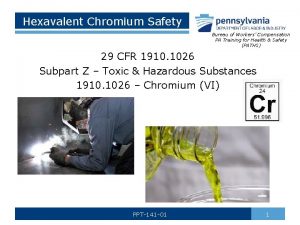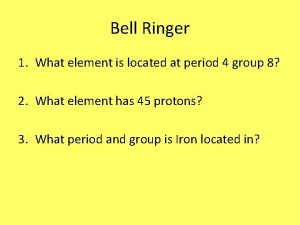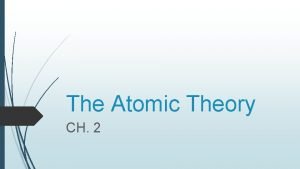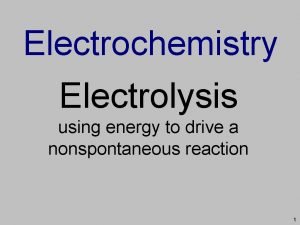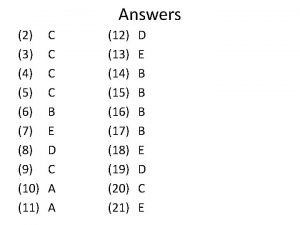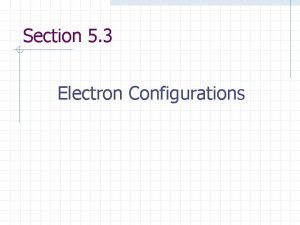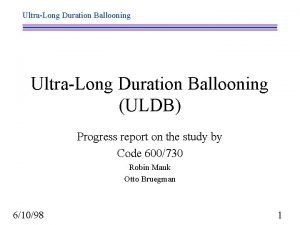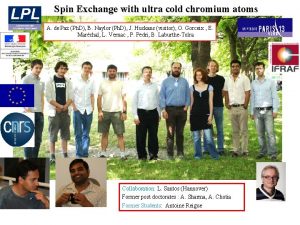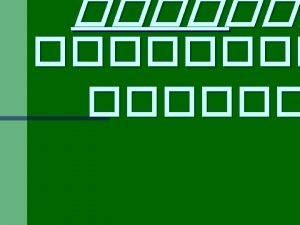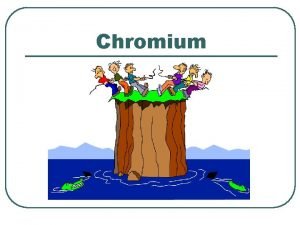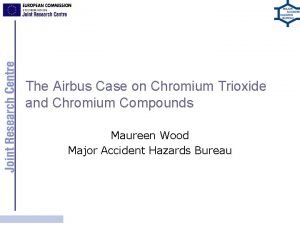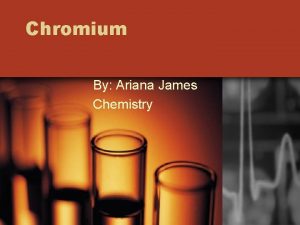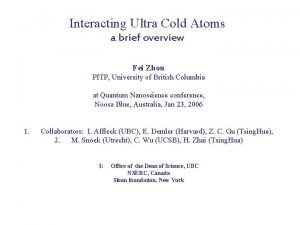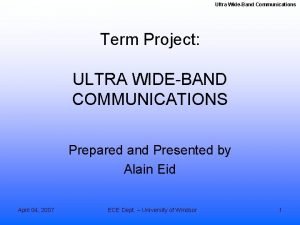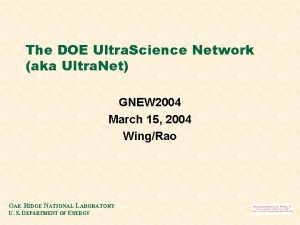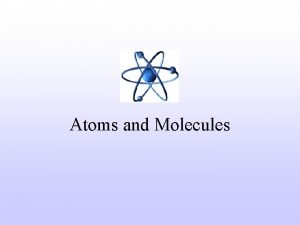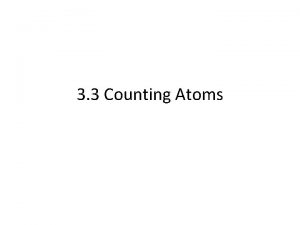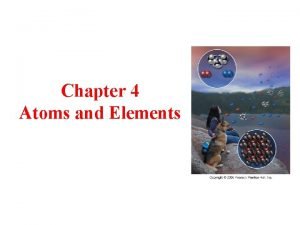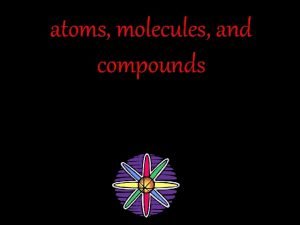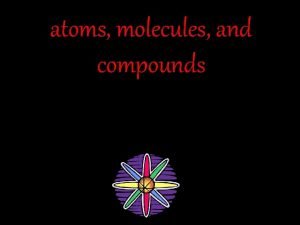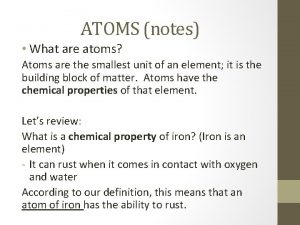Recent results with ultra cold chromium atoms A




































- Slides: 36

Recent results with ultra cold chromium atoms A. de Paz (Ph. D), B. Naylor, A. Sharma (post-doc), A. Chotia (post doc), J. Huckans (visitor), O. Gorceix , E. Maréchal, L. Vernac , P. Pedri, B. Laburthe-Tolra Collaborations: L. Santos (Hannover) Students: Antoine Reigue, Ariane

Outline Quantum Magnetism with ultracold bosons Production of a chromium Fermi sea

Quantum Magnetism: what is it about? What is (are) the (quantum) phase(s) of a given crystal at "low" T ? Heisenberg Hamiltonian anti ferromagnetic Magnetism ie quantum phases not set by ddi but by exchange interactions

Quantum Magnetism with cold atoms tunneling assisted super exchange U

Quantum Magnetism with a dipolar species in a 3 D lattice Vdd Ising term magnetic dipole moment dipole-dipole interactions direct spin-spin interaction real spin long range = beyond the next neighbor Vdd = 10 -20 Hz Exchange term quantum regime, high filling factor T < 1 n. K to reach ground state Spin dynamics in an out of equilibrium system S=3

Quantum Magnetism with a chromium BEC in a 3 D lattice 3 S=3 Cr BEC loaded in a 3 D lattice: a Mott state -1 -2 0 1 2 -3 spin preparation, measurement of the evolution of the Zeeman states populations different spin dynamics induced by dipole-dipole interactions spin exchange 3 constant magnetization -2 -1 0 1 2 change of the magnetization -3 magnetization = 3 dipolar relaxation -2 -3 -1 0 1 2

Dipolar relaxation in a 3 D lattice - observation of resonances nx , n y , n z k. Hz (Larmor frequency) 1 m. G = 2. 8 k. Hz width of the resonances: tunnel effect + B field, lattice fluctuations

Spin exchange dynamics in a 3 D lattice 10 m. G B 0 first resonance dipolar relaxation suppressed evolution at constant magnetization spin exchange from -2 experimental sequence: -1 -2 -3 ce ca i t p i att l l o ad n in Lo te sta atio r a p pre 2 vary time Stern Gerlach analysis

Different Spin exchange dynamics in a 3 D lattice Contact interaction (intrasite) expected Mott distribution

Different Spin exchange dynamics in a 3 D lattice Contact interaction (intrasite) Dipole-dipole interaction (intersite) without spin changing term dipolar relaxation with expected Mott distribution doublons removed = only singlons

Spin exchange dynamics in a 3 D lattice: with only singlons the spin populations change! E(ms) = q m. S 2 comparison with a plaquette model (Pedri, Santos) 3*3 sites , 8 sites containing one atom + 1 hole quadratic light shift and tunneling taken into account measured with interferometry Proof of intersite dipolar coupling Many Body system

Spin exchange dynamics in a 3 D lattice with doublons at long time scale intersite dipolar coupling result of a two site model: two sites with two atoms dipolar rate raised (quadratic sum of all couplings) not fast enough: the system is many body our experiment allows the study of molecular Cr 2 magnets with larger magnetic moments than Cr atoms, without the use of a Feshbach resonance

Dipolar Spin exchange dynamics with a new playground: a double well trap idea: direct observation of spin exchange with giant spins, "two body physics" compensating the increase in R by the number of atoms realization: load a Cr BEC in a double well trap + selective spin filp R -3 N atoms +3 N atoms frequency of the exchange: precession of one spin in the B field created by N spins at R R = 4 µm j = 3 Hz B field created by one atom N = 5000

Spin exchange dynamics in a double well trap: realization realizing a double well spin preparation RF spin flip in a non homogeneous B field -3 +3

Spin exchange dynamics in a double well trap: results No spin exchange dynamics

Inhibition of Spin exchange dynamics in a double well trap: interpretation (1) What happens for classical magnets? evolution in a constant external B field evolution of two coupled magnetic moments q

Inhibition of Spin exchange dynamics in a double well trap: interpretation (2) Evolution of two coupled magnetic moments in presence of an external B field What happens for quantum magnets in presence of an external B field when S increases? no spin changing terms 2 S+1 states Ising contribution gives different diagonal terms Ising term Exchange term "half period" of the exchange grows exponentially if no more exchange possible no complete exchange It is as if we had two giant spins interacting

Contact Spin exchange dynamics from a double well trap after merging without merging Spin exchange dynamics due to contact interactions Fit of the data with theory gives an estimate of a 0 the unknown scattering length of chromium

Production of a degenerate quantum gas of fermionic chromium Two very different quantum statistics T < Tc a quantum gas at T<Tc T > Tc or T<<TF a quantum gas at T<<TF

Production of a degenerate quantum gas of fermionic chromium A quantum gas ? 3 D harmonic trap Degeneracy criteria Chemical Potential

Production of a degenerate quantum gas of fermionic chromium So many lasers… 7 P 4 53 Cr MOT : Trapping beams sketch 53 Cr MOT : laser frequencies production 7 S 3 Lock of Ti: Sa 2 is done with an ultrastable cavity

Production of a degenerate quantum gas of fermionic chromium Loading a one beam Optical Trap with ultra cold chromium atoms direct accumulation of atoms from the MOT in mestastable states RF sweep to cancel the magnetic force of the MOT coils crossed dipole trap for 53 Cr : finding repumping lines

Production of a degenerate quantum gas of fermionic chromium Spectroscopy and isotopic shifts unknown 5 D J=3 → 7 P° J=3 for the 52 // 5 D J=3 F=9/2 → 7 P° J=3 F=9/2 for the 53 Shift between the 53 and the 52 line: 1244 +/-10 MHz Deduced value for the isotopic shift: Center value = 1244 -156. 7 + 8 = 1095. 3 MHz Uncertainty: +/-(10+10) MHz (our experiment) +/-8 MHz (HFS of 7 P 3) isotopic shift: - mass term - orbital term

Production of a degenerate quantum gas of fermionic chromium Strategy to start sympathetic cooling make a fermionic MOT, load the IR trap with 53 Cr more than 105 53 Cr make a bosonic MOT, load the IR trap with 52 Cr about 106 52 Cr inelastic interspecies collisions limits to not great, we tried anyway… 3. 104 53 Cr + 6. 105 52 Cr

Production of a degenerate quantum gas of fermionic chromium Evaporation

Production of a degenerate quantum gas of fermionic chromium Why such a good surprise? Maybe we reach the hydrodynamic regime for the fermions… If collisions with bosons set the mean free path of fermions below the trap radius How to measure Fermion-Boson collision cross section? By heating selectively and quickly the bosons and then measure fermions thermalization very preliminary measurements + analysis support this interpretation then fermions are trapped by collisions

Production of a degenerate quantum gas of fermionic chromium Results In situ images Expansion analysis Nat parametric excitation of the trap frequencies Temperature slightly degenerated

Production of a degenerate quantum gas of fermionic chromium What can we study with our gas? 9/2 7/2 5/2 Fermionic magnetism Phase separation 3 very different from bosonic magnetism ! 2 Picture at T= 0 and no interactions 0 -1/2 -3/2 -5/2 -7/2 -2 -3 1/2 1 -1 3/2 -9/2 Boltzmann Population in m. F=-9/2 requires good in situ imaging T=10 n. K T=50 n. K Fermi T=0 T=200 n. K minimize Etot Larmor frequency (k. Hz)

thank you for your attention!

Dipolar Quantum gases van-der-Waals Interactions dipole – dipole interactions BEC R Tc= few 100 n. K Isotropic Short range comparison of the interaction strength alcaline Anisotropic Long Range for chromium the BEC can become unstable dysprosium for 87 Rb erbium polar molecules

Preparation in an atomic excited state creation of a quadratic light shift m. S = -2 -3 energy Raman transition s- p -3 -2 -1 0 1 2 A s- polarized laser Close to a J J transition (100 m. W 427. 8 nm) 3 -1 -2 -3 -1 quadratic effect (laser power) laser power -3 1 0 -1 -2 -3 -2 transfer in -2 ~ 80% -3 transfer adiabatic -2

Dipolar Relaxation in a 3 D lattice 3 0 -3 -2 1 2 -1 kinetic energy gain Ec is quantized dipolar relaxation is possible if: + selection rules If the atoms in doubly occupied sites are expelled

Spin exchange dynamics in a 3 D lattice with doublons at short time scale initial spin state onsite contact interaction: contact spin exchange in 3 D lattice: Bloch PRL 2005, Sengstock Nature Physics 2012 spin oscillations with the expected period strong damping

Different Spin exchange dynamics with a dipolar quantum gas in a 3 D lattice expected Mott distribution intrasite contact -1 -2 -3 intersite dipolar Heisenberg like hamiltonian quantum magnetism with S=3 bosons and true dipole-dipole interactions doublons removed = only singlons intersite dipolar de Paz et al, Arxiv (2013)

Spin changing collisions V V' -V -V' from the ground state from the highest energy Zeeman state -1 +3 -2 +2 -3 spin changing collisions become possible at low B field the Cr BEC can depolarize at low B fields At low B field the Cr BEC is a S=3 spinor BEC dipolar relaxation +1 after an RF transfer to ms=+3 study of the transfer to the others m. S rotation induced dipole-dipole interactions induce a spin-orbit coupling Cr BEC in a 3 D optical lattice: coupling between magnetic and band excitations

Spin changing collisions V V' -V -V' from the ground state -1 -2 -3 spin changing collisions become possible at low B field 1 m. G (a) 0. 5 m. G (b) 0. 25 m. G (c) « 0 m. G » (d) -3 the Cr BEC can depolarize at low B fields At low B field the Cr BEC is a S=3 spinor BEC -2 -1 0 1 2 3 As a 6 > a 4 , it costs no energy at Bc to go from m. S=-3 to m. S=-2 : stabilization in interaction energy compensates for the Zeeman excitation
 A friend emails you the results
A friend emails you the results Nu skin facial cleansing bar
Nu skin facial cleansing bar Compared to atoms of metals, atoms of nonmetals generally
Compared to atoms of metals, atoms of nonmetals generally Quantum gas
Quantum gas The cold war begins lesson 1
The cold war begins lesson 1 How to write ammonium phosphate
How to write ammonium phosphate Cr orbital diagram
Cr orbital diagram Hexavalent chromium training
Hexavalent chromium training Hexavalent chromium uses
Hexavalent chromium uses Group 8 elements
Group 8 elements Hexavalent chromium safety program
Hexavalent chromium safety program Chromium 63 protons neutrons electrons
Chromium 63 protons neutrons electrons Chromium bohr model
Chromium bohr model What mass of chromium could be deposited by electrolysis
What mass of chromium could be deposited by electrolysis Chromium orbital configuration
Chromium orbital configuration Chromium vi phosphate
Chromium vi phosphate Aufbau principle
Aufbau principle Bac 5625
Bac 5625 Chromium etchant 1020
Chromium etchant 1020 Https drive google com
Https drive google com Jose has just played a long bruising football game
Jose has just played a long bruising football game Ap synthesis prompt
Ap synthesis prompt Recent demographic changes in the uk
Recent demographic changes in the uk Recent trends in ic engine
Recent trends in ic engine Can backdated udin be generated
Can backdated udin be generated Explain recent trends in foreign trade of india
Explain recent trends in foreign trade of india Powerschool myips
Powerschool myips Recent advances in dental ceramics
Recent advances in dental ceramics Recent developments in ict
Recent developments in ict Recent trends in mis
Recent trends in mis In recent years evidence has been collected
In recent years evidence has been collected Biotaphonomy
Biotaphonomy Sports news in passive voice
Sports news in passive voice Recent developments in object detection
Recent developments in object detection Https drive google com drive u 0 recent
Https drive google com drive u 0 recent Modern trends in project management
Modern trends in project management Ultra long duration balloon
Ultra long duration balloon



